Sunny California is more than just a place where the stars live, it is a diverse ecosystem filled with abundant plant and animal life. Some of the best bird-watching spots in the world exist in California. And many species may even be right in your backyard. Discover 10 common blue birds in California and learn about their habitats, migration, appearance, and diet.
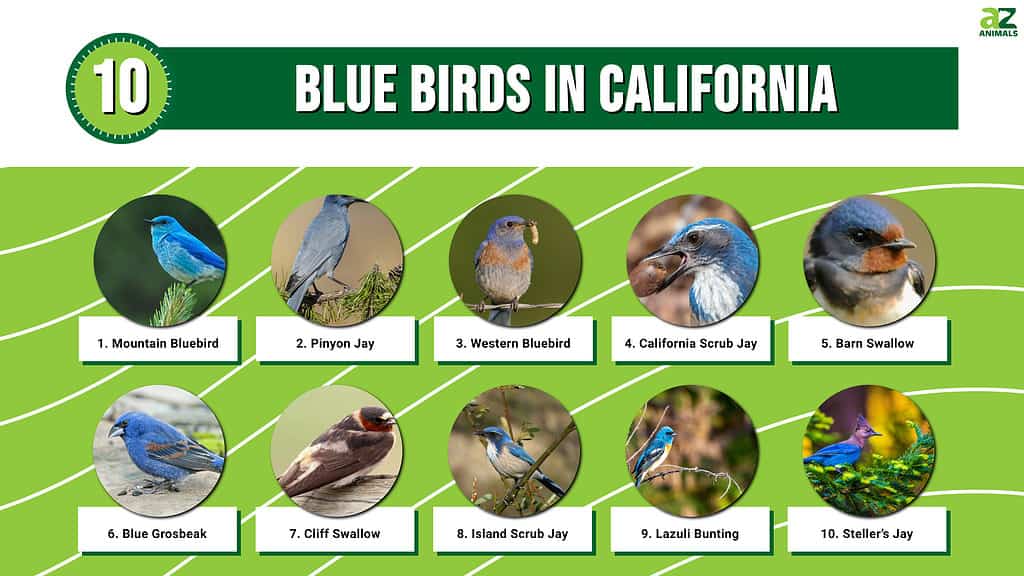
1. Mountain Bluebird
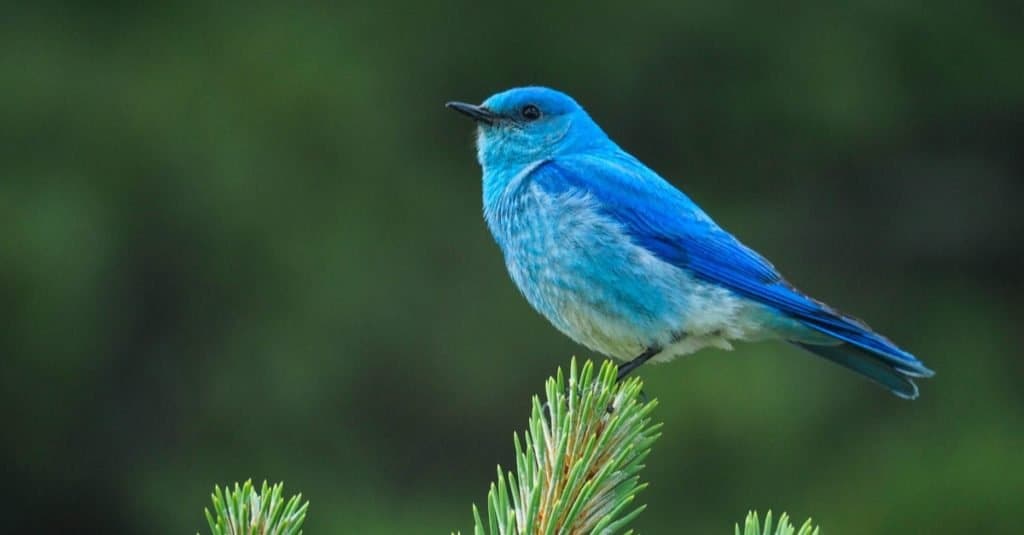
The
mountain bluebird
is a medium-sized bird weighing about one ounce with a length of 6-8 inches.
©MTKhaled mahmud/Shutterstock.com
Range and Habitat: Mountain bluebirds inhabit most of California except for the coastline. The state is unique for this species because breeding populations can be found in the northern regions, and they migrate to southern California for winter. In summer, they live up to 12,000 feet above sea level in prairies, meadows, and pastures. They winter in lower elevations in grasslands, woodlands, and agricultural areas.
Migration: They breed in Northeastern Canada and the United States and winter in the southwest and Mexico.
Size and Color: They are 6 to 8 inches long, weigh a little over one ounce, and have an 11 to 14-inch wingspan. Males are varying shades of sky blue above and pale below.
Diet: Caterpillars, beetles, grasshoppers, small fruits, and seeds make up their diet.
Feeder Food: These bluebirds don’t eat at feeders but may visit a nest box.
2. Pinyon Jay
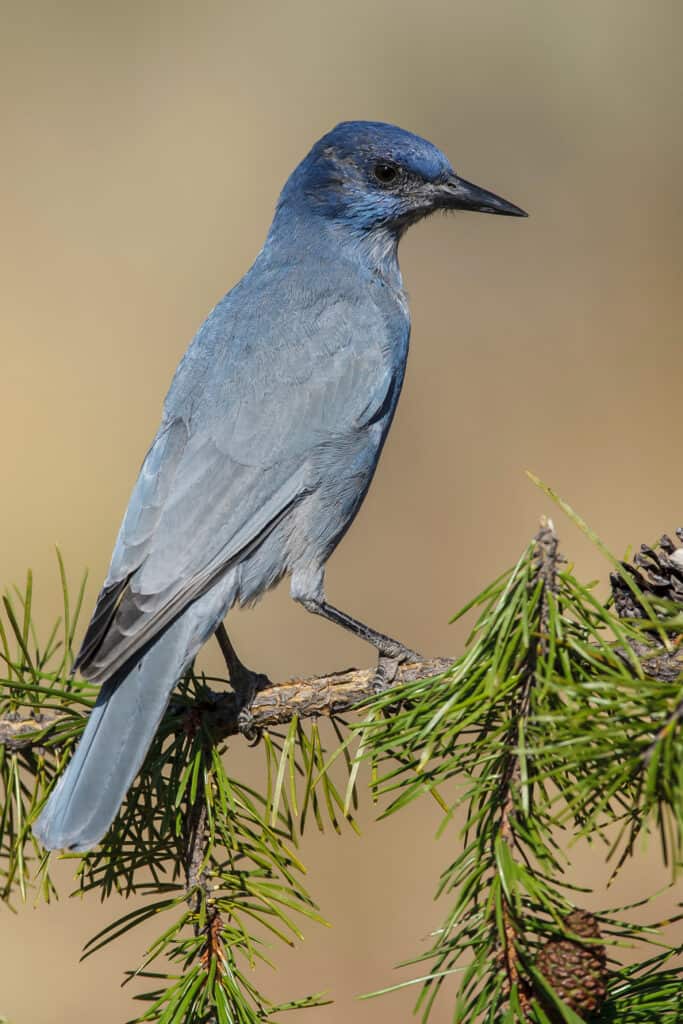
Pinyon jays live in the far eastern regions of California, and they do not stray far from pinyon-juniper woods.
©Agami Photo Agency/Shutterstock.com
Range and Habitat: Pinyon jays are typically found in the far eastern regions of California or wherever pinyon pines exist. Some populations may migrate closer to the coast for winter. They do not stray far from pinyon-juniper woods but may occasionally inhabit groves and oak woods.
Migration: They are permanent residents in the interior portions of the West. But they may move to find food when pinyon trees fail to produce seeds.
Size and Color: They weigh three to four ounces, measure 10 to 11 inches long, and have an 18-inch wingspan. They are dusky to grayish-blue with darker heads and lighter bellies.
Diet: Their diet is pinyon pine seeds, nuts, berries, grains, and insects.
Feeder Food: Peanuts, sunflower seeds, suet, and cracked corn will attract this species to your yard.
3. Western Bluebird
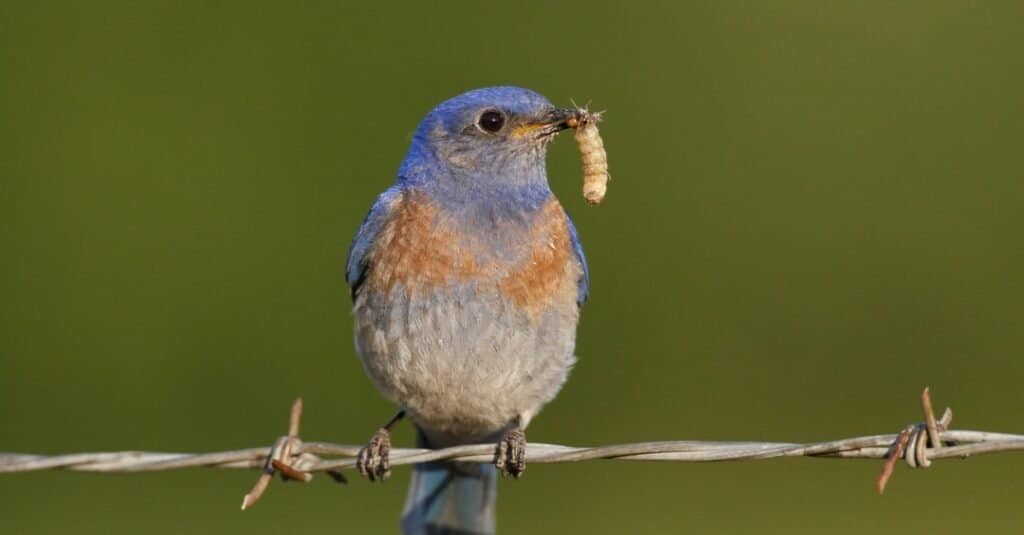
Western bluebirds like to eat a variety of foods, including grasshoppers, caterpillars, beetles, ants, fruits, and seeds.
©iStock.com/mooninwell
Range and Habitat: California has a large resident population of western bluebirds, especially along the coast. But those that breed in the northeastern part of the state will migrate to Central California for winter. They live in open woodland edges, preferring evergreen and deciduous woods.
Migration: Their population is rather scattered. But most breed in the Northwest and winter in the Southwest and Mexico. However, many will live year-round in their southwestern environment.
Size and Color: The western bluebird weighs between 0.8 and one ounce and measures 6-7 inches long with an 11 to 13-inch wingspan. They are vibrant blue above and rusty orange below.
Diet: They like to eat a variety of foods, including grasshoppers, caterpillars, beetles, ants, wasps, fruits, and seeds.
Feeder Food: If you want to attract this bird, scatter mealworms in your yard.
4. California Scrub Jay

California scrub jays closely resemble blue jays. They live year-round in California in oak woodlands and scrub.
©Pierre Leclerc/Shutterstock.com
Range and Habitat: The California scrub jay lives year-round in California, except for the southeastern region. They live in oak woodlands and scrub, but you can also spot them in foothill forests, suburbs, and parks.
Migration: These birds are nonmigratory. They are permanent residents along the western coast in Washington, Oregon, California, and Mexico.
Size and Color: This species is larger than the western bluebird, measuring 11 inches and weighing two to three ounces, with a 15-inch wingspan. These birds are azure and gray above and white below.
Diet: Their diet is made up of insects, fruits, nuts, seeds, lizards, and nestlings.
Feeder Food: Sunflower seeds and peanuts will attract this species.
5. Barn Swallow
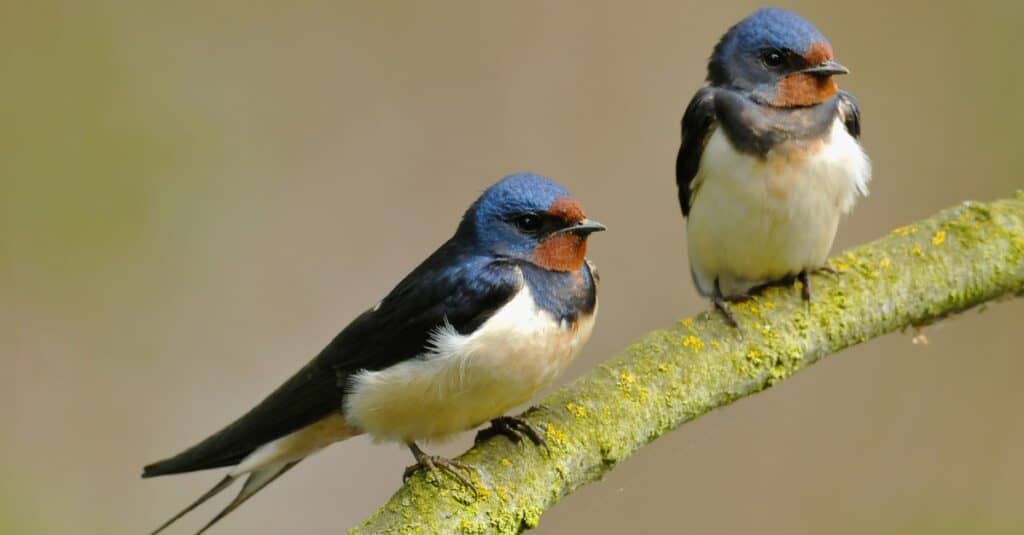
Barn swallows breed in Northern California and migrates through Southern California. They inhabit farms, fields, and parks.
©CezaryKorkosz/Shutterstock.com
Range and Habitat: Barn swallows breed in Northern California and along most of the coastline. And they migrate through the southern portion of the state. They live in many semi-open habitats, like farms, fields, parks, and marshes.
Migration: This species breeds throughout most of Canada and the United States and winters in Mexico and Central America.
Size and Color: These swallows are slightly smaller than a bluebird and measure six to seven inches, and weigh less than an ounce, with an 11 to 12-inch wingspan. They are dark blue above and tawny below with cinnamon-colored faces.
Diet: Flies, beetles, bees, wasps, ants, and moths are their favorites.
Feeder Food: They are drawn to ground-up eggshells or oyster shells!
6. Blue Grosbeak
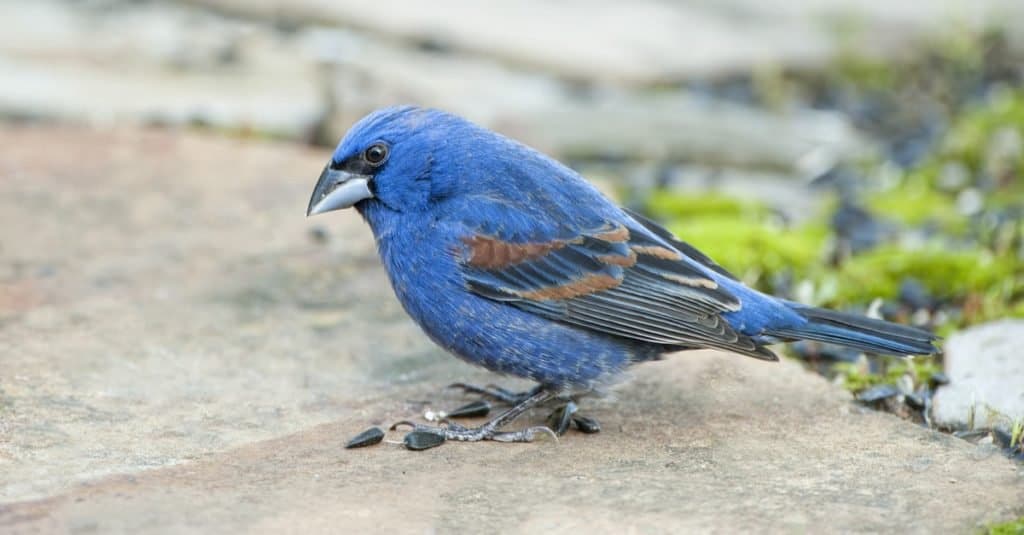
The
blue grosbeak
breeds in Southern California in old fields, forest edges, and southern pine forests.
©Bonnie Taylor Barry/Shutterstock.com
Range and Habitat: Blue grosbeaks are found in the far southern regions of California during spring and summer. You will find these birds in old fields, forest edges, deserts, and southern pine forests.
Migration: They breed across the Southern United States, migrate along the coasts, and winter in Mexico and Central America.
Size and Color: This species weighs around one ounce and measures 6 inches long, with an 11-inch wingspan. They are deep, rich blue all over with chestnut wing bars and silver bills.
Diet: They prefer grasshoppers, crickets, snails, seeds, and grains.
Feeder Food: Grains and seeds will attract them.
7. Cliff Swallow

The cliff swallow appears dark from afar, but upon closer inspection, you can see they are dark blue, white, gray, and reddish-brown.
©iStock.com/SteveByland
Range and Habitat: Cliff swallows breed across California, especially in the northern regions. They like semi-open habitats near water, such as prairies, forest clearings, and desert rivers.
Migration: They breed in Southern Canada and most of the United States, migrate through the Southeast, Mexico, and Central America, and winter in South America.
Size and Color: These birds measure around 5 inches long and feature an 11-inch wingspan. They have dark blue backs and caps, reddish-brown faces, white underparts, and dark gray wings and tails.
Diet: Their diet features flies, bees, ants, wasps, beetles, butterflies, moths, grasshoppers, and crickets.
Feeder Food: This species does not visit feeders.
8. Island Scrub Jay
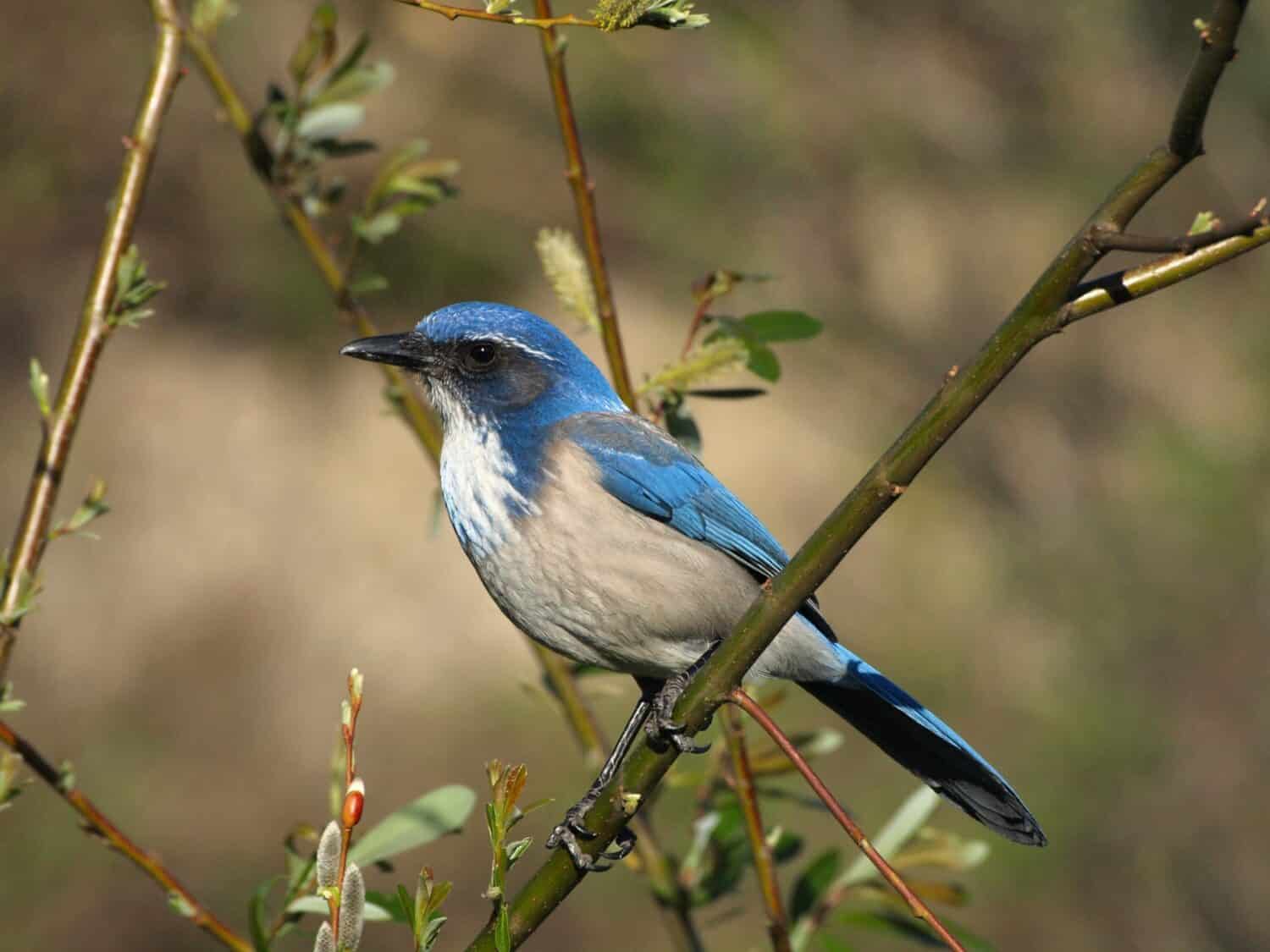
The Island Scrub Jay is also known as the Santa Cruz Jay.
Image: Gregg M. Pasterick, Shutterstock
©Gregg M. Pasterick/Shutterstock.com
Range and Habitat: The island scrub jay lives permanently on Santa Cruz Island off the coast of Southern California. You will find them in oak woodlands and chaparral.
Migration: These birds are nonmigratory and do not stray from their island home.
Size and Color: This island species is larger than the western scrub jay and features dark blue and gray plumage.
Diet: Insects, seeds, and berries comprise their diet.
Feeder Food: The island scrub jay does not visit feeders due to the species’ remote location.
9. Lazuli Bunting
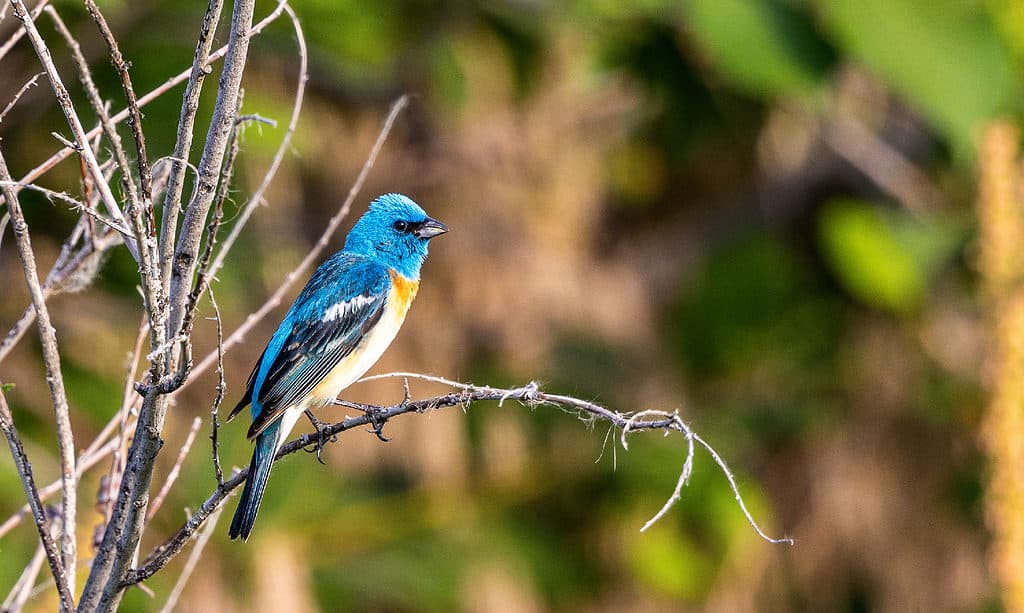
Lazuli buntings breed in most of California in scrub oaks, thickets, sagebrush, and pinyon-juniper woods.
©iStock.com/Jeff Edwards
Range and Habitat: Lazuli buntings breed throughout California, except for the southeastern corner. They inhabit scrub oaks, thickets, sagebrush, and pinyon-juniper woods.
Migration: They breed in the northwest, migrate through the southwest, and winter along Mexico’s coast.
Size and Color: They are smaller than the western bluebird, measuring 5 inches long and weighing around half an ounce, with an 8-inch wingspan. They are brilliant blue above and white below with light orange breasts.
Diet: They consume caterpillars, grasshoppers, spiders, beetles, ants, berries, and seeds.
Feeder Food: White proso millet, nyger, and sunflower seeds are their favorite snacks.
10. Steller’s Jay
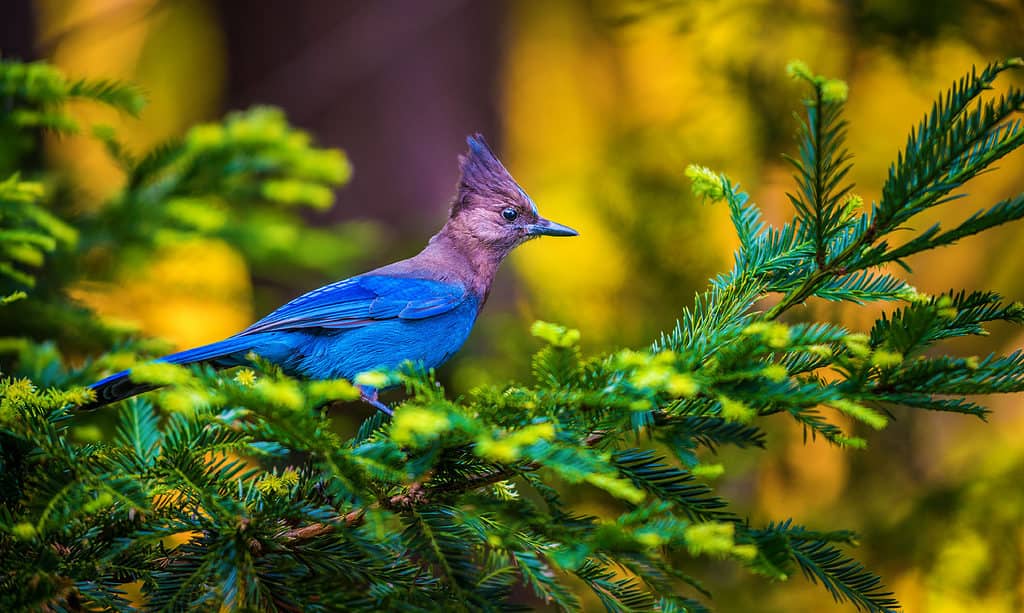
The Steller’s Jay is a year-round resident in California. You can spot them in forests, parks, and other woodland habitats.
©iStock.com/kwiktor
Range and Habitat: The Steller’s jay lives year-round in a significant portion of California but they are absent from the state’s central region. They inhabit pine, spruce, and fir forests and many other woodland habitats. You may also spot them in suburban parks.
Migration: They are permanent residents in the Western United States, Southwest Canada, and Western Mexico.
Size and Color: These birds measure between 11 and 13 inches long, weigh three to five ounces, and feature a 17-inch wingspan. Their plumage is charcoal black and deep blue.
Diet: They eat seeds, berries, nuts, insects, small mammals, and eggs.
Feeder Food: Suet, peanuts, and other large seeds attract this species.
Summary of 10 Blue Birds in California
| # | Bird | Appearance |
|---|---|---|
| 1 | Mountain Bluebird | Varying shades of sky blue above with light blue bellies |
| 2 | Pinyon Jay | Dusky to grayish-blue with darker heads and lighter bellies |
| 3 | Western Bluebird | Vibrant blue with rusty-orange chests |
| 4 | California Scrub Jay | Azure and gray above and white below |
| 5 | Barn Swallow | Dark blue above and tawny below with cinnamon-colored faces |
| 6 | Blue Grosbeak | Deep, rich blue all over with chestnut wing bars and silver bills |
| 7 | Cliff Swallow | Dark blue backs and caps, reddish-brown faces, white underparts, and dark gray wings and tails |
| 8 | Island Scrub Jay | Dark blue and gray plumage with a lighter belly |
| 9 | Lazuli Bunting | Brilliant blue above and white below with light orange breasts |
| 10 | Steller’s Jay | Deep blue and charcoal black plumage with purple |
The photo featured at the top of this post is © iStock.com/janugio
Thank you for reading! Have some feedback for us? Contact the AZ Animals editorial team.






